“Olympic Torch Relay Detoured Through San Francisco Back Streets,” screamed the headlines. “Protest Forces Cancellation of Closing Ceremony.”
That’s the basic gist of what happened in San Francisco on April 9. All very neat and tidy, it would seem. Most people scanned the headlines and moved on.
If you took the time to read the full news accounts, you would have also learned that tens of thousands of demonstrators from around the country had gathered in San Francisco to protest against China’s human rights record. But fearing a public-relations disaster if the torch was extinguished or seized by the unruly crowd, the mayor and city officials at the last minute secretly changed the previously announced route of the torch relay so that it completely bypassed all the protesters, who had lined up hoping to get a glimpse of the torch and draw attention to their cause.
With the torch route diverted, all the protesters (and supporters) of the relay were left in the lurch, feeling confused and angry. The assembled global media, perhaps hoping for more exciting disruptions (as had happened in Paris and London over the previous days), were disappointed as well, and portrayed the whole day as a misfire.
But was it really?
The media inevitably resort to generalizations when describing complicated events. The details get lost. Yet life is nothing but a long series of details. At a major protest like this, when tens of thousands of people gather in one place, when emotions erupt and a million little vignettes unfurl, no simple headline can fully describe all that went on. Hell, even with a full-length photo essay like this, I can’t fully illuminate the day’s many facets either. No one could.
Even so, I’ll try my best to find the story behind the news. What started as a stage-managed Olympic photo op first descended into political chaos, then in an instant became an irrelevant sideshow as the relay went in a different direction altogether — and the day ended with a desperate cross-town footrace as relentless protesters (and yours truly) managed to outrun the Olympians and catch the torch at the finish line.
Ready? On your marks…Get set…Let’s go!
I arrived over an hour before the scheduled relay start time only to find, to my initial surprise, supporters of the Beijing Olympics lining the route. The fact that they all had identical oversized Chinese flags, souvenir t-shirts, and even little paper American flags led me to believe that the Chinese government had organized the whole scene.
I quickly discovered that the anti-China protesters were massed a short distance away. Not only did they already outnumber the China supporters, but the crowd was growing minute by minute as people streamed toward San Francisco’s Embarcadero (on the waterfront) to join the protest.
It wasn’t long before they came into conflict. Here a China supporter expresses his disapproval of a banner blaming China for the situation in Darfur.
As the crowds swelled on both sides of he political aisle, mere disapproval rapidly escalated to all-out confrontation. Arguments between China supporters and detractors broke out all over the Embarcadero.
There was no strict physical separation between the opposing sides, though at first the China supporters tended to stay on one side of the Embarcadero while the protesters clustered on the other side with occasional forays into the street. Though even this unofficial arrangement disintegrated fairly quickly.
As the time for the relay grew closer, the conflicts between the two sides grew more heated. Discussions became arguments became mass screaming matches whenever two opposing groups came near each other — which became unavoidable as hundreds more people poured into the area with every passing minute.
But I’m getting ahead of myself. Who were all these protesters, and what did they want?
The Protesters
Typical news reports about protests never tell you the exact nature of who’s protesting or why. Which I’ve always found rather odd. Mainstream media outlets inevitably focus on whether or not there was violence, and how many people were arrested. But they’ll rarely discuss the issues underlying the protest in the first place.
So you may be wondering: What’s the hubbub all about?
Turns out a lot of people have a beef with China. I counted at least 20 different causes being championed at the protest, on a dizzying array of topics.
First, of course, were the Tibetans and their supporters, who were there in force: thousands upon thousands of people showed up to condemn China’s actions in Tibet, starting with Mao’s invasion in 1950 up to yesterday, when dissidents were shot and killed in a fresh round of repression.
The second largest contingent were the Darfur supporters, who blamed China for propping up the genocidal Sudanese regime.
Next up were the Burmese dissidents, who demanded that China stop supporting the repressive military dictatorship there.
The Uyghurs had a surprisingly large turnout. Their cause is not widely known in the U.S. — the Uyghurs are a Muslim minority group in far western China that want independence, or at least greater autonomy. China labels Uyghur separatists as Islamic terrorists, though it’s doubtful there’s any substance to the accusation.
Taiwanese Nationalists turned up en masse to warn China: Keep your hands off. The Communist government still regards the island of Formosa as a breakaway province illegally occupied by a defeated rebel army.
All sorts of Vietnamese protesters showed up by the hundreds, drawing attention to myriad causes little known outside the Vietnamese community. For example…
The Paracel and Spratly Islands took center stage in one area of the rally. The dispute over these tiny coral reefs in the South China Sea might seem a bizarre issue to get worked up over, but the islands’ potential global significance has become clear in recent years, as they are now thought to sit atop huge underwater oil and natural gas fields. China illegally seized the Paracels from the crumbling South Vietnamese government in 1974 and never gave them back, while the oil-rich Spratlys are claimed by China, Vietnam, and several other nearby nations.
These folks are apparently still miffed over China’s 1979 invasion of Vietnam.
The littlest protester stood up for the lives of Vietnamese deep-water fishermen who reportedly have been massacred on the open sea recently by predatory Chinese ships operating under instructions from the government — an apparent attempt to wrest fishing rights away from Vietnam. The excellent sign depicts one of the cutesy 2008 Olympic mascots as a vicious monster holding a burning human bone instead of an Olympic torch as it sinks a Vietnamese fishing boat.
But it was more than just Asian nations pointing out the evils of the Chinese government. Other groups were there as well, including…
Anti-fur activists, angry about the factory fur trade in China, where animals are mistreated so horrifically that it’s hard to even contemplate.
Several protesters encouraged people to buy American-made products and boycott Chinese goods, to reverse the lopsided trade imbalance between the two nations and to stop the Chinese economic juggernaut.
Labor activists decried China’s treatment of workers and its anti-union policies.
I’m not quite sure what Lou Gehrig’s Disease has to do with China, but hey — I’m all for stamping it out!
And lastly, this one-man protest accused somebody of stealing Kosovo from somebody else, but the particulars of the theft eluded me.
The Chinese government supplied oversized heads of the Olympic mascots, which were designed to make everyone feel warm and fuzzy but only ended up looking out-of-place and discordant with the deadly serious tone of the protest. Here we see Huanhaun and Yingying. Huanhuan is supposed to represent fire, and Yingying (I kid you not) is supposed to be, of all things, a Tibetan antelope. Could you get any more ironic?
They even handed out mascot signs, in a futile attempt to cutify the protest.
There was some kind of official Olympic performance going on nearby in Justin Herman Plaza, but it was very ill-attended — most of the people in the audience seemed to be the troups of performers themselves. The vast majority of those who came to the Torch Relay came to raise a political ruckus — not watch a canned propaganda show.
Before the protesters showed up and ruined everything, the Embarcadero area was supposed to host a celebration of traditional Chinese culture at the closing ceremony of the torch relay. And even though everything had gone to pot, the scheduled performances went forward anyway, mostly ignored by the huge crowd. Here, traditional dragon dancers walk warily near the protest, doing very little in the way of dancing.
One of the Tibetan groups drew a large crowd throughout the day with an impressive bit of rolling political street theater involving a faux Chinese tank and Chinese soldiers beating and torturing protesters dressed as Buddhist monks.
Notice the Grade-A moron on the left, who made the brilliant decision to wear a Chairman Mao shirt to the rally, as some kind of birdbrained fashion statement — even though he was hanging around with the anti-Chinese Tibetan protesters. It takes a special kind of stupid to be that oblivious.
The dolt also stood directly between the street theater and the faux tank for most of the performance, smirking the whole time and completely ruining the scene for all the other photographers. It’s like he was trying to be annoying.
Back in the trenches, the ongoing battles continued. Here, one China supporter gives a mocking laugh and a thumbs down to some Tibetans.
Though the China supporters were far outnumbered by anti-China protesters, they made up for it in fervor.
When there were no opponents in the immediate vicinity to challenge, they chanted slogans in Chinese anyway. In the absence of the torch relay, there wasn’t much to do if you wanted to show your support for China.
Sometimes the conflicts became personal. These two went at it for what seemed like half an hour. They guy on the right is a China supporter who stationed himself in the middle of a large Tibet contingent, and waved a communist Chinese flag back and forth. The guy on the left took out a whistle and blew it in his face incessantly — when they weren’t exchanging insults.
At one point some random guy grabbed a China supporter by the arm. When challenged as to what justification he had, he claimed he was making a citizen’s arrest because a Tibetan protester (holding a sign in the background) claimed the China supporter had struck him. The fight devolved into further accusations and counter-accusations, needless to say.
Signs
Many of the anti-China signs contained sarcastic reinterpretations of the Olympic rings. This was one of my favorites.
I was intrigued by this guy’s sign and asked him if the swastikas were supposed to be the kind that are a Buddhist good luck symbol, since the color scheme seemed to suggest a Tibetan connection. Or, alternately were they, “y’know, the bad kind.” He looked a little puzzled and said “The bad kind,” then admitted he never knew they were ever used in any other context.
Ouch. Every other protest sign criticized the Chinese government, but this one uniquely pointed out the hypocrisy of the China supporters at the rally.
What I find particularly entertaining about this sign is that it contained no topical reference at all. It could fit in at any protest. In fact, you could just walk down the street with it any day of the week and see what kind of reaction you got.
I was expecting more signs with Olympics-themed protest metaphors, but this is the only one I saw all day.
The hyper-detailed hand-painted poster was a masterpiece of political art — if you stood close enough to it to see all the details.
Tibetan organizers had distributed signs reading “Another ________ for Free Tibet,” allowing people to fill in their own identities. Some of the self-descriptions, as these examples show, were surprisingly frank.
When I first arrived, the police had cordoned off portions of the esplanade for no apparent purpose; later, they would take down some of the barricades and then set up others. If you monitored their activity you might have come to the same conclusion I did, that they were moving barriers around and opening and closing sections of the street at random for the specific purpose of deceiving the protesters, a ruse to make it look like they were preparing for the torch relay to come through, but knowing all along that it was never arriving.
This series of photos shows the breakdown of security at the main protest site. The relay was supposed to start at 1:00pm several blocks south, and reach here at the Embarcadero area around 1:15 or 1:20. As the clock on the Ferry Building shows, an hour ahead of time at 12:10, the street was completely clear.
Attendees lined the relay route all the way down to the site of the opening ceremony — and the street was unimpeded all the way.
12:30 — the street was still pretty much clear.
With ten minutes to go until the relay began, the crowd had swollen considerably but the police deployed along the street to theoretically keep everyone on the sidewalk.
Then, a very short time later, the whole situation disintegrated. Within a matter of minutes, the entire street from one end to the other was swarming with thousands of people. I’ve seen the S.F police in action — if they want to keep a crowd on the sidewalk, believe me, the crowd stays on the sidewalk. But in this situation the police in fact didn’t seem to mind at all when security broke down and the torch route swarmed with protesters. I didn’t see exactly how it all happened, but my impression was that the police let it happen as an excuse to justify the previously planned secret re-routing of the torch relay. Notice the smile on the cop at the lower left. If the torch really was on the way here in a few minutes, he wouldn’t be smiling.
The international media was there en masse, hoping for the same kind of picturesque chaos that had plagued the London and Paris legs of the torch relay. If you think the protesters were disappointed that the torch was re-routed, imagine how the reporters felt.
At one point a large contingent of China supporters decided to challenge the Tibet supporters head on. Waving communist Chinese flags and carrying Olympics placards, they plunged into the heart of enemy territory, shouting taunts and insults.
A group of college-age American Tibet supporters linked arms, knelt down, and silently stared down the invaders, who proceeded to mock them before retreating in triumph. Everyone on both sides was happy with the outcome; these symbolic battles seem to satisfy a innate need for confrontation.
The Tibetans made creative use of “girl power,” a protest technique that has proven very effective over the decades. There were very few, if any, teenaged Tibetans boys visible at the protest, but dozens and dozens of teenaged Tibetan girls.
Was this gender imbalance accidental? Or part of a strategy? Or do Tibetans only give birth to daughters?
I got the feeling it was intentional: The Tibetan protest movement seems media savvy and is very adept at creating photogenic scenes, whether it be street theater (as shown above), young women…
…or wise old men in traditional costumes.
This Burmese democracy protester bore an uncanny resemblance to detained Burmese opposition leader Aung San Suu Kyi.
“Oh, dearie me, did he really say that?” A woman appears aghast at the blunt words spoken by a fellow China supporter.
“Free Tibet, bitches!” That‘ll tell ’em. I can’t imagine the Chinese government not freeing Tibet after catching sight of this shirt.
In an odd way this was the most disturbing protest I’d ever been to — because it thoroughly reconfigured the traditional political landscape. I’m no fan of the Chinese government, and for the most part sympathized with the causes of the protesters. Because of this I ended up on the same side as people whom I normally loathe — such as this guy, who I’ve seen many times at anti-Israel protest and who has more than once revealed himself to be an anti-Semite. And here I am, agreeing with him on Tibet. Very unnerving.
Same holds true for anybody wearing a kaffiyeh, the type of person I would normally avoid at all costs.
Why does politics have to be so complicated?
The Race for the Torch
Sometime after 1:30 an official-looking car tried to drive slowly through the tighly packed crowd, with little success. I overheard several people speculating that it was a “test run” for the torch entourage. But if an unimportant car couldn’t even make it through the crowd, it seemed, the torch itself — which everyone would converge on — would have no chance at all of passing unmolested. Rumors ran through the rally that the torch relay was being cancelled.
Which may have been a wise decision, as I noticed that various protest groups had brought fire extinguishers and had positioned them at points along the route — undoubtedly foreshadowing an attempt to douse the flame when it passed, as happened during the torch relay a few days earlier in Paris.
Sometime around two o’clock I noticed something very odd happening on the outskirts of the protest. A few people — almost all of whom were visibly holding iPhones or similar electronic devices — began sprinting northward along the Embarcadero. I caught up with one man as he paused to scrutinize his iPhone, and asked him what was going on. He said that an underground text-message system had been set up by tech-savvy radical protesters, and if you knew how to access it, you could get minute-by-minute updates about the exact current location of the torch. Just a short time earlier, one of the scouts for the network had discovered the torch entourage traveling north up Van Ness Avenue — several miles away, completely bypassing the main protest site. Logic dictated that the torch must be heading to Fisherman’s Wharf by the “back way,” instead of along the Embarcadero.
In a flash, people starting racing pell-mell north up the Embarcadero toward Fisherman’s Wharf, in an attempt to catch the torch relay. But only a tiny fraction of the crowd even knew about what was happening, and an even smaller fraction had the physical wherewithal to sprint two miles. So 99% of the protesters remained behind.
Yet what choice did I have? I started running.
Things were not so simple, however. We were chasing a moving target. If I happened to pass an iPhone owner, I’d shout “Where’s the torch now?” and get the latest update, if I was lucky. But the pursuers began to spread out through the streets of the city, and I soon lost any contact with the secret text-message network, so my fellow low-tech joggers and I resorted to a clever trick: We navigated by the location of the police helicopters hovering in the distance.
I felt as if I was chasing a mirage. The futher I staggered in the direction of the helicopters, the further away they seemed to recede.
Over a mile later, I encountered a cluster of exhausted Tibetans who claimed the torch was heading for a specific intersection. I followed as they dashed down the block, but yet again it turned out to be a wild goose chase: when we arrived, the torch was nowhere to be found.
I immediately headed off again after the helicopters, utterly out of breath, and reconnected with some folks wired into the mobile network, who said the relay had changed course yet again and was currently moving westward along San Francisco’s Marina Boulevard — heading in the complete opposite direction from the original announced route.
Onward we staggered. Most people were unable to continue running at this stage, and were walking as quickly as their bodies would let them.
I rounded a corner and — huzzah! — spotted police lights a throng of motorcyle cops in the distance. The finish line was in sight!
With a fresh burst of speed I hurtled toward the commotion and caught the torch as it passed the Marina Green, the city’s waterfront park.
I was fortunate: the entourage had paused briefly to change runners. I soon learned that there were in fact two torches, and when one runner finished his or her segment of the route, the first torch was used to ignite another torch held by the next runner — just like in a real relay race, which explains why it’s called the Olympic Torch Relay.
Phalanxes of police defended the torch as it was handed to the next runner. Which really didn’t seem that necessary, since only a few hundred people were on hand — not many protesters had found their way to the relay’s location. I later calculated that I had run over four miles to reach the torch.
The new runner waved to the crowd, eliciting scattered boos and cheers from the meager (and mostly exhausted) crowd.
An unexplained delay allowed me to catch my breath. The previous runner stood there holding the old torch, which the Chinese security team has failed to douse. He seemed unsure what to do with it.
After a few minutes the procession started up again. The police moved forward to their new defensive positions, and “El Pato” — a yellow amphibious vehicle normally used for tourist excursions but pressed into service as the torch’s military escort — rolled forward.
After a short distance the torch was passed to a runner in a wheelchair.
As the procession entered the Presidio, a fracas broke out across the street. From what I could tell, a protester had attempted to breach the security cordon, with no success. Police tackled him immediately. It happened so fast, I only got this one blurry shot of the action.
The torch was handed to woman who looked like a professional athlete, and without warning the procession rapidly accelerated. The cops guided her up a freeway onramp to Doyle Drive — which is the approach to the Golden Gate Bridge. As soon as she ascended the ramp, the cops turned on the pursuing crowd and formed a barrier, preventing any onlookers or protesters from following the relay any further.
The chase was on again. Spotting the torch on the elevated roadway up ahead, people swarmed toward the Golden Gate Bridge through the Presidio.
Some gave up in exhastion and sat down on the lawn.
By this time fewer than a hundred people were left, out of an original crowd that must have numbered tens of thousands. We tried to find an alternate access point to Doyle Drive, but were thwarted at every turn by the police.
One determined Tibetan protester had somehow managed to climb up an inaccessible stairway, but was immediately arrested before he could even get to the roadway.
The few remaining diehards scrambled up to a vantage point overlooking Doyle Drive, and discovered that the procession had come to a halt at an inaccessible spot on the freeway — inaccessible on purpose, apparently.
Those in the final group who had cell phones received calls from other protesters monitoring the police radio: the torch had been transferred to a bus, and instead of going across the Golden Gate Bridge as we had all assumed, it instead was being driven straight to the airport, and thence to Buenos Aires, the next stop on the torch’s global route.
San Francisco Mayor Gavin Newsom claimed this whole change of course was a last-minute decision — that in fact they were deciding on the route as they were running through the streets — but the well-executed and complicated conclusion to the relay proves that it had been planned well in advance. This was no last-minute re-routing — they were trying to trick the protesters all along.
I managed to snap this photo of the torch bus as it passed. Behind it, in the distance, you can see Alcatraz. Which seems a fitting conclusion to the journey.
Zombie is an undercover photographer. His work is displayed at Zombietime.


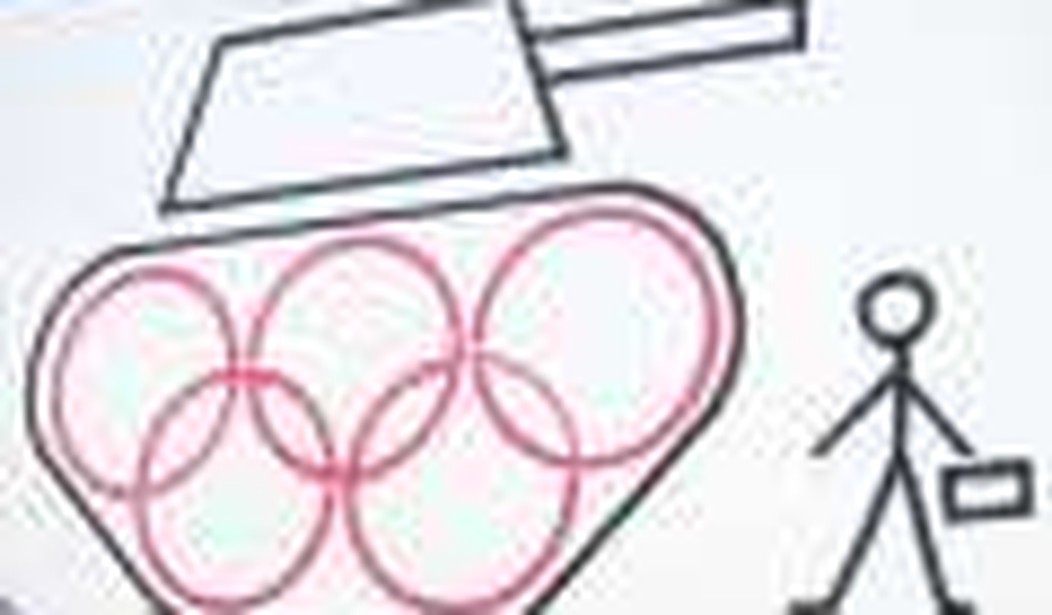
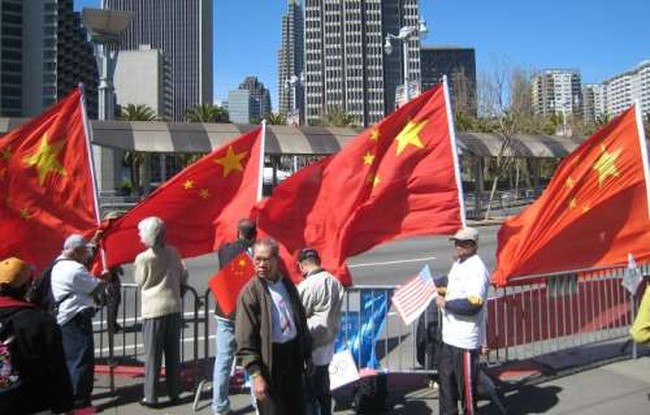
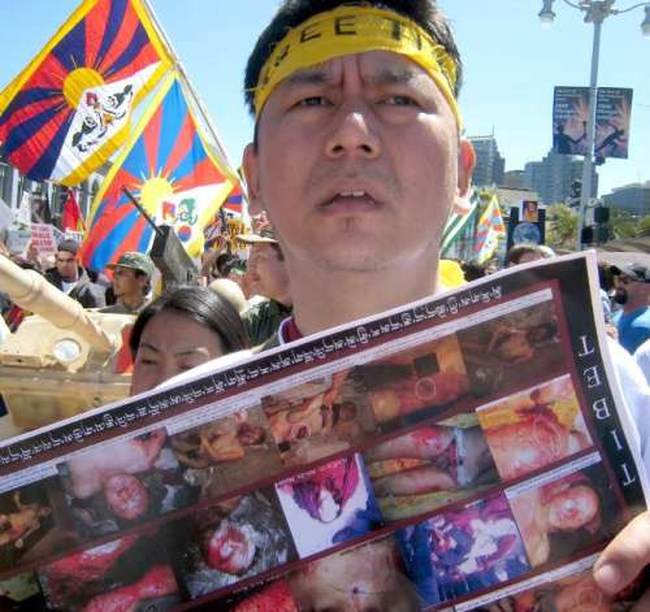
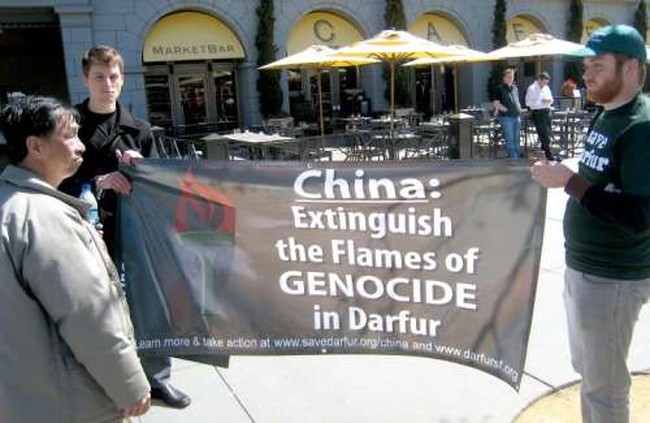
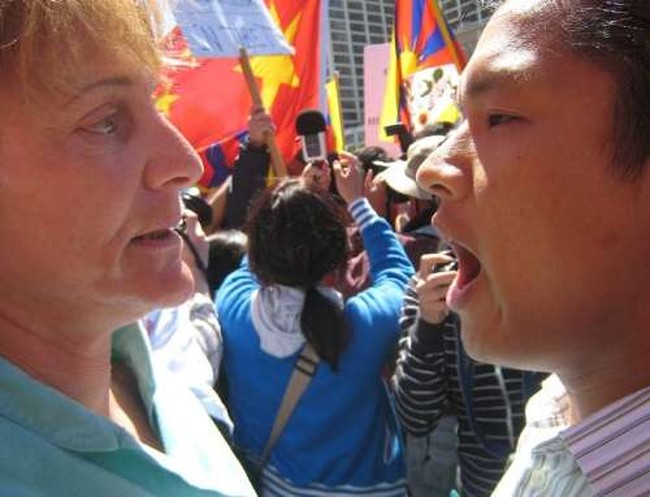
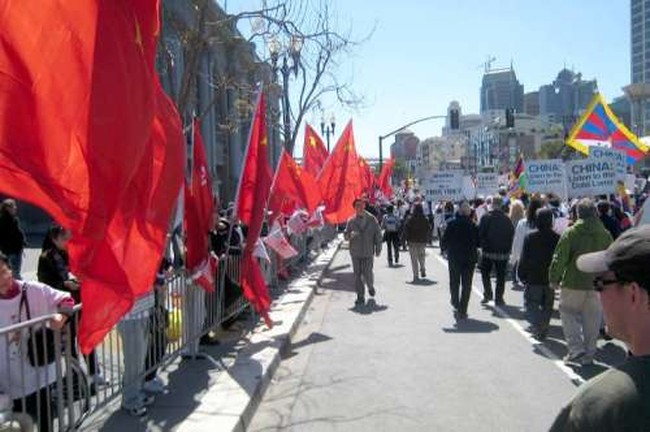
































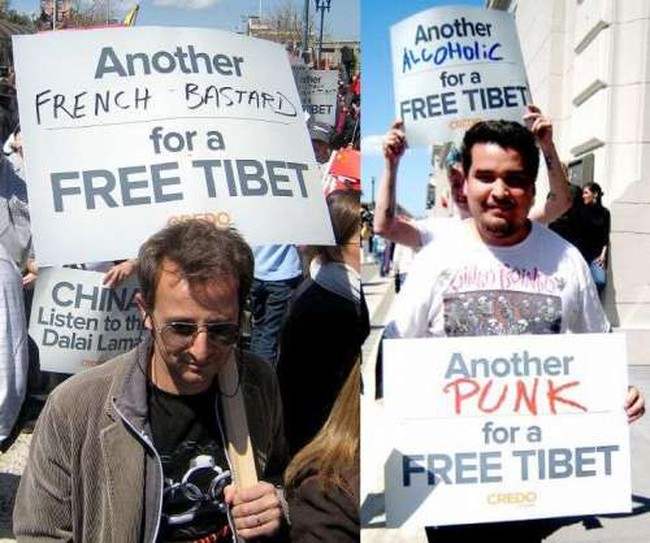














































Join the conversation as a VIP Member